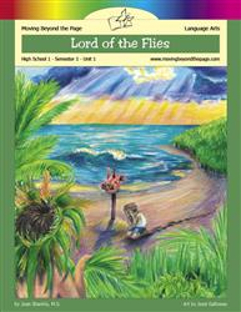Beyond the Page (BTP) has published complete programs for pre-kindergarten through eighth grade for homeschoolers who prefer a secular approach. Some of their courses can also be used for ninth grade even though they are not exclusively for high school. Now BTP has introduced its first course specifically for high school with Language Arts: High School 1.
Language Arts: High School 1 is a comprehensive, one-year language arts course that teaches grammar, literature, critical thinking, and composition skills, with access to BTP’s online spelling program included. The course covers all of the Common Core State Standards for both ninth and tenth grade so that it can be used at either grade level. It should take students about one and a half hours per day to complete the lessons.
The course consists of nine worktexts, each covering one unit, plus additional required books. The worktexts have colorful covers, but the inside pages are printed in black and white. Worktexts can be purchased in either print or PDF versions. The additional books students will need are:
- The Only Grammar Book You’ll Ever Need by Susan Thurman
- The Only Grammar & Style Workbook You’ll Ever Need by Susan Thurman
- Lord of the Flies by William Golding
- The Crossover by Kwame Alexander
- 100 Best-Loved Poems by Philip Smith
- A Long Way Gone by Ishmael Beah
- I Am Malala by Malala Yousafzai
- Ender's Game by Orson Scott Card
- Outliers by Malcolm Gladwell
- A Raisin in the Sun by Lorraine Hansberry
- Romeo and Juliet by William Shakespeare
Students will also access videos and educational information online at BTP, YouTube, and numerous educational websites via links kept up to date by BTP.
The nine units at first seem like they are sharply divided between literature and grammar since two of them are titled Grammar and Grammar, Part II, while other units are titled Lord of the Flies, Short Stories, Poetry, Nonfiction, Ender’s Game, Informational Texts, and Drama. While the two grammar units do focus particularly on grammar, all of the other units incorporate activities that deal with grammar as well as literature, literary analysis, reading comprehension, composition, vocabulary, public speaking, and critical thinking.
Different authors wrote these units, and consequently, the design of each unit varies greatly. For example, in the Nonfiction unit, students read the book Outliers. Lessons 3 and 4 address a topic covered in that book, the “10,000 Hour Rule” that says that it takes 10,000 hours of practice to master a musical instrument, sport, hobby, or similar skill. Author Malcolm Gladwell uses specific examples such as the Beatles and Bill Gates to support his theory. In these lessons, students will answer questions with paragraph-length answers, complete an activity page that helps them analyze how Gladwell develops his points, discuss three questions presented by the parent or teacher, track the information in Gladwell’s book on either the Beatles or Bill Gates, and present that information in a visual format (using graphics and online tools provided through weblinks).
In contrast, Lesson 13 in the Drama unit has students read the end of Romeo and Juliet. They will answer several comprehension questions, watch three online videos, answer questions in a journal, learn about character development, learn how Shakespeare drew on older works for inspiration, complete four graphic organizers, and prepare a monologue to recite for an audience.
The variety of learning activities should appeal to students with different learning styles. Even the Grammar units use occasional videos, graphic organizers, and creative activities. Some lessons, as well as the “wrapping up” activities at the end of both Grammar units, have students choose mini-projects from options that include creative expression and art. In a more traditional vein, along with the two Grammar unit worktexts, students will use The Only Grammar Book You’ll Ever Need and its companion workbook.
The Only Grammar Book You’ll Ever Need is a handbook rather than a course. While it covers the basics, it primarily deals with advanced grammar issues and common problems. The workbook provides practice exercises that indicate on which page in the handbook the concept being practiced is taught. Even students with a strong grammar foundation should benefit from these lessons.
Composition skills are covered extensively in the other seven units since most writing skills are developed within the context of literature studies. Students write expository, comparison-contrast, and persuasive essays, as well as other types of writing such as literary analysis, technical writing in the form of a how-to guide, oral presentations, and their own short story. Worktexts often present questions that must be answered in sentences or paragraphs. Space for those answers is often provided in the worktexts, but students will also need to write other assignments in a notebook or on a computer.
Substantial teacher information is in a section titled “Parent Overview” at the back of each worktext. Teaching notes, discussion questions, and answer keys are found there. It might be tempting to let students work independently and skip the discussion questions or other interactive elements, but they are critical parts of the course. Parents might want to remove these pages from the books both for easy reference and to avoid tempting students who might peek at answers. This alone might be a good reason to purchase the worktexts as PDFs rather than printed books.
Language Arts: High School 1 takes an unusually creative approach to language arts that teens are likely to appreciate. While the content is challenging, the variety of projects that suit different learners should make the course accessible to most students.








